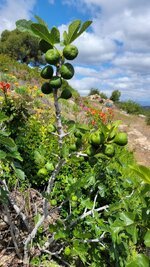I’ve got a fig tree growing on a steep slope on my property, mixed with native plants and succulent ground cover. It was already there when we moved in about 10 years ago. It had been cut down to the ground at some point but grew back into a small bush. I never really paid attention to it until now, since I’ve gotten more serious about growing figs.
Questions:
- Tree looks super healthy.
- Lots of green figs growing on last year's wood (I think profichi?).
- No mamme crop anywhere (on the tree or ground).
Questions:
- Could this be a caprifig? I opened one fig but couldn’t really tell (pic attached).
- If it’s a caprifig, is there any way to figure out what variety it is?
- When would I expect to see fig wasps around it, if any?
- Where can I learn more about starting/maintaining a wasp colony?










